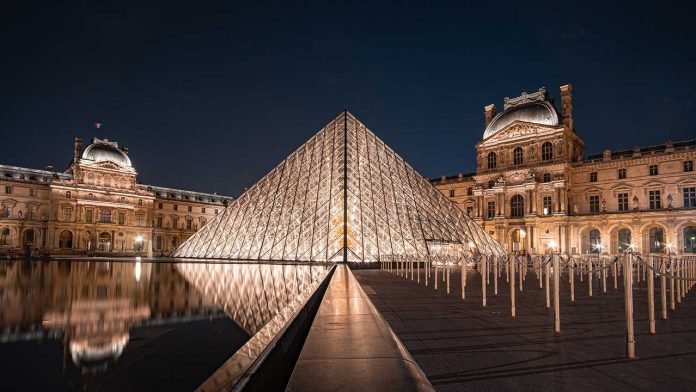
The Louvre Museum, a sublime expression of Parisian culture, offers an unmatched voyage through the annals of art history. It serves not merely as a museum but as a monument to human creativity and a tribute to the world of art. One cannot claim to have truly experienced Paris without getting lost in the Louvre’s labyrinthine corridors, immersing oneself in the astonishing collection of masterpieces, and locking eyes with the enigmatic Mona Lisa. In the heart of Paris, the Louvre stands as a testament to the enduring power and allure of art.
The City of Lights, as Paris is often fondly called, is a fascinating blend of history, romance, and unparalleled art. If there is one icon that combines all these facets, it is undoubtedly the Louvre Museum, an awe-inspiring edifice that epitomizes the French devotion to the arts and is home to a plethora of the world’s finest art masterpieces.
Practical Information: Planning Your Visit
Visiting the Louvre requires planning due to its vastness. Start early and consider investing in a map or a guide. As of 2023, the museum is open every day except Tuesdays and certain public holidays. If you’re an art enthusiast who prefers a quieter visit, consider choosing a Wednesday or Friday evening when the museum extends its hours until 9:45 pm.
History of the Louvre: From Fortress to Museum
The Fortress Beginnings (12th Century): In the late 12th century, King Philip II ordered the construction of a fortress to protect Paris from potential invasions. Situated on the western edge of the city, this fortress included a keep (the Great Tower) and a moat. The remnants of this medieval structure can still be seen in the lower levels of the museum today.
Transition to a Royal Palace (16th Century): During the 16th century, the Louvre transitioned from a fortress into a royal residence under King Francis I. It was Francis who initiated a significant transformation of the Louvre, inviting artists such as Leonardo da Vinci to France and beginning the Louvre’s journey to becoming a center of art and culture.
Expansion and Beautification (17th and 18th Centuries): Kings Louis XIII and Louis XIV, and their respective ministers, continued to expand and embellish the Louvre with grand apartments, galleries, and gardens. However, when Louis XIV chose to move his court to the Palace of Versailles in 1682, the Louvre ceased to be the main royal residence but continued its function as a place to display the royal collections.
The Louvre as a Public Museum (19th Century): During the French Revolution, the National Assembly decreed that the Louvre should serve as a museum to display the nation’s masterpieces. The Musée Central des Arts opened in the Grande Galerie of the Louvre in 1793. Throughout the 19th century, successive governments expanded the museum’s collection through acquisitions, archaeological expeditions, and donations.
World Wars and Restoration (20th Century): During the World Wars, the Louvre’s priceless collections were evacuated and hidden to protect them from potential damage. The museum itself suffered some damages during World War II but underwent restoration and reopened to the public.
Recent Developments (21st Century): In the 21st century, the Louvre has continued to evolve. It has seen significant restoration projects, international partnerships (such as the Louvre Abu Dhabi), and adaptations to modern technology to enhance visitor experience.
The Louvre Architecture: A Masterpiece in Itself
Renaissance and French Classical Designs: The original fortress was gradually transformed through successive renovations, particularly under the reign of Francis I, who was captivated by Italian Renaissance art and architecture. The renowned architect Pierre Lescot was commissioned to rebuild the Louvre in the 1540s, and his designs, later continued by other architects, reflect the influence of the Renaissance. The Cour Carrée, a grand square courtyard, is one of the most notable examples of this period.
The Louvre Pyramid: In 1984, French President François Mitterrand proposed the Grand Louvre plan to renovate the building and relocate the Ministry of Finance, allowing the Louvre to be a museum in its entirety. I.M. Pei was selected as the chief architect of this project. His controversial design for a glass and steel pyramid was initially met with resistance but has since become an iconic part of the Louvre’s identity. The Pyramid was inaugurated in 1989 and serves as the museum’s main entrance.
Integration and Harmony: The Louvre is a testament to architectural integration. I.M. Pei’s modernist pyramid, while a stark contrast to the classical style of the palace, was designed to align with the historic axes of Paris, connecting the old and new in a harmonious relationship.
Today, the Louvre is not just a museum; it is also an architectural masterpiece that narrates the history of Paris itself, standing as a symbol of the enduring cultural spirit of France.
The Art Collection: A Universe of Masterpieces
With its vast collection of over 35,000 artworks, a day at the Louvre can feel like stepping into an alternative universe of artistic expressions. Spanning from the birth of great ancient civilizations up to the first half of the 19th century, the museum’s collection includes pieces from around the globe, ensuring a multi-faceted, multicultural artistic experience. Here are some notable artworks held at the Louvre:
- The Mona Lisa: Painted by Leonardo da Vinci, the Mona Lisa is one of the most famous and iconic paintings in the world. It is known for its enigmatic smile and is a must-see when visiting the Louvre.
- The Raft of the Medusa: Created by Théodore Géricault, this large-scale painting depicts the aftermath of a shipwreck and is considered a masterpiece of French Romanticism.
- The Winged Victory of Samothrace: This ancient Greek sculpture of Nike, the goddess of victory, is renowned for its dynamic pose and exquisite craftsmanship.
- The Venus de Milo: This ancient Greek statue of the goddess Aphrodite (Venus) is admired for its graceful beauty and is one of the most famous sculptures in the world.
- The Wedding at Cana: Painted by Paolo Veronese, this monumental artwork depicts the biblical miracle of turning water into wine. It is known for its intricate details and vibrant colors.
- The Coronation of Napoleon: Painted by Jacques-Louis David, this grand masterpiece portrays the coronation of Napoleon Bonaparte as Emperor of the French. It showcases the opulence and power of the Napoleonic era.
- The Code of Hammurabi: This ancient Babylonian stele contains one of the oldest known legal codes. It is inscribed with laws and punishments and provides valuable insights into ancient Mesopotamian society.
- The Death of Sardanapalus: Created by Eugène Delacroix, this painting is considered a classic example of Romantic art. It was inspired by the tale of the Assyrian king Sardanapalus, who, according to the story, ordered the destruction of his palace and possessions when facing defeat in battle.
- Liberty Leading the People: Also painted by Eugène Delacroix, this iconic work commemorates the July Revolution of 1830 in France. It features a woman personifying Liberty leading a diverse group of people forward over the bodies of the fallen.
- The Lacemaker: Painted by Johannes Vermeer, this delicate and intimate painting is a remarkable example of the Dutch Golden Age, showcasing Vermeer’s exquisite technique and attention to detail.
- Psyche Revived by Cupid’s Kiss: This stunning marble sculpture was created by Antonio Canova. It is regarded as a masterful representation of Neoclassical sculpture and depicts the moment when the god Cupid, depicted as a young man, revives his lover Psyche with a kiss.
- The Madonna of the Rocks: Another masterpiece by Leonardo da Vinci, this painting showcases the Virgin Mary, Christ, John the Baptist, and an angel in a rocky and mysterious landscape. It is one of the most celebrated examples of Leonardo’s interest in nature and his skill in rendering atmospheric effects.
- St. John the Baptist: Also by Leonardo da Vinci, this painting is a striking and enigmatic portrait of John the Baptist in isolation. It is noted for its engaging and mysterious quality, characteristic of Leonardo’s mature style.
- Portrait of Louis XIV: Painted by Hyacinthe Rigaud, this artwork is a grand, full-length portrait of Louis XIV of France in his coronation robes. This iconic image was instrumental in crafting the Sun King’s royal persona.
- The Seated Scribe: This painted limestone statue from the Old Kingdom of Egypt depicts a seated man in a scribe’s pose. It is remarkable for its lifelike qualities and the detailed execution of the face and hands.
- The Winged Bull of Sargon: This is an imposing, monumental stone sculpture of a winged bull with a human face. It once stood guard at the palace of Sargon II, an ancient Assyrian king. The sculpture is a lamassu, a protective deity, and is an iconic example of Assyrian art.
- These artworks represent a small fraction of the extensive and varied collection held at the Louvre, which spans from ancient civilizations to the 19th century and includes paintings, sculptures, decorative arts, and more.
These are just a few examples of the incredible artworks held at the Louvre. The museum’s collection spans across various mediums, including paintings, sculptures, decorative arts, and archaeological artifacts, offering visitors a rich and diverse artistic experience.


















